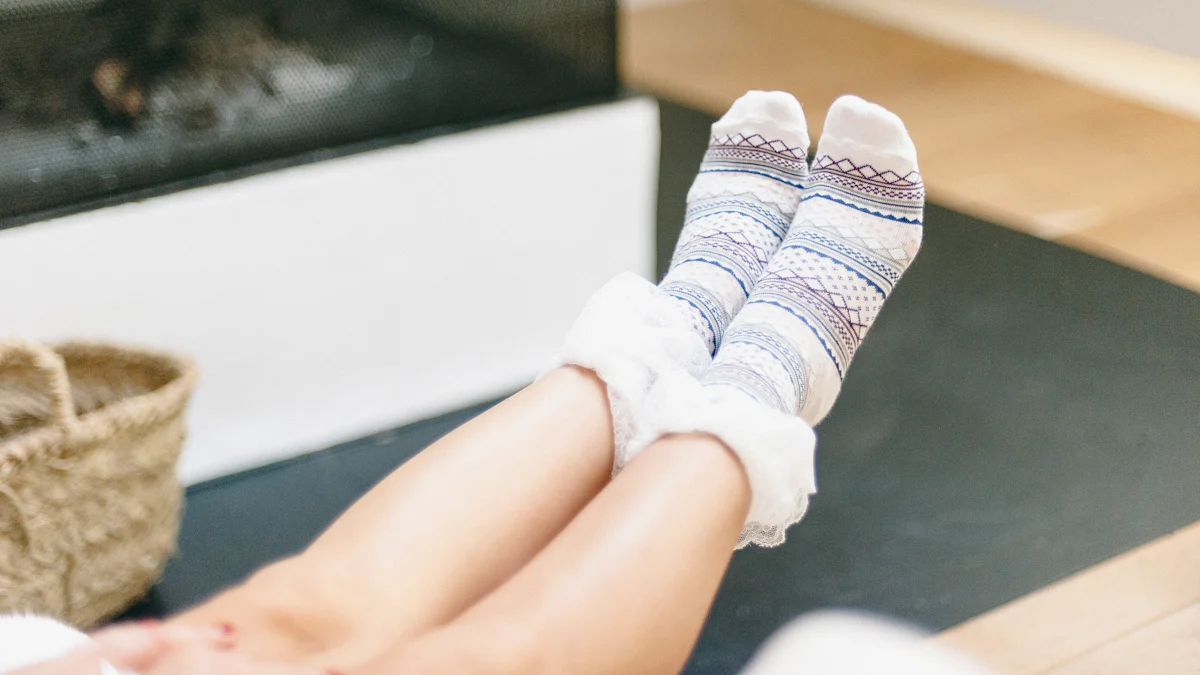
Choosing the right children socks is very important. Poorly made socks can cause blisters, sores, and infections. Socks that don’t fit well rub against the skin, leading to pain and injuries. Breathable children socks keep feet dry and prevent athlete’s foot. Changing socks often helps avoid smelly feet. This blog provides tips to choose comfortable and healthy children socks.
Basics of Kids’ Socks
Why Proper Fit Matters
Good fitting socks keep feet comfy and healthy. They stay in place without bunching up. Measure your child’s feet to get the right size.
Measuring Feet
Use a ruler to measure the length and width of both feet. Compare these measurements with the sock size chart. Make sure the heel of the sock matches your child’s heel.
Signs of Bad Fit
Badly fitting socks can hurt and cause problems. Look for red marks, blisters, or tight lines on the skin. Socks that slide down or bunch up don’t fit well.
Sock Materials
The material of socks affects comfort and how long they last. Different materials have different pros and cons.
Natural vs. Synthetic Fibers
Natural fibers like cotton are soft and let feet breathe. Wool keeps feet warm. Synthetic fibers like polyester make socks strong and stretchy. Blends mix both types for better features.
Breathability and Moisture-Wicking
Breathable fabrics let air in, keeping feet dry. Cotton is great for everyday use because it breathes well. Polyester wicks away sweat, preventing fungal infections.
Types of Kids’ Socks
Different activities need different socks. Pick based on what your child does.
Everyday Socks
These are comfy for daily wear, often made from cotton blends. Look for reinforced toes and heels for durability.
Sports Socks
Sports socks give extra support during physical activities. They wick away moisture to keep feet dry and have padding for comfort.
Seasonal Socks
Seasonal socks match weather needs. Light ones are good for summer; thick ones keep feet warm in winter.
Special Considerations
Age-Specific Needs
Kids of different ages need special socks. Picking the right ones keeps them comfy and healthy.
Infants and Toddlers
Little kids need soft, breathable socks. Cotton is good for their skin. Make sure they fit well to stop slipping. Avoid tight bands that can hurt circulation. Look for socks with gentle elastic.
School-Aged Children
School kids do many activities. Choose strong socks with reinforced toes and heels. Breathable cotton blends keep feet dry. Ensure they fit well to avoid discomfort during play.
Teenagers
Teens have specific tastes. Think about style and function. Sports socks that wick away sweat are great for active teens. Make sure they fit well to prevent blisters.
Sensitivity and Allergies
Some kids have sensitive skin or allergies. The right materials can stop irritation.
Hypoallergenic Materials
Hypoallergenic materials lower the chance of allergic reactions. Look for organic cotton or bamboo socks. These are gentle on the skin and free from harsh chemicals.
Seamless Socks
Seamless socks stop irritation from seams. Kids with sensory issues like these socks best. Ensure they fit snugly but not tightly. Seamless socks give comfort without causing friction.
Practical Tips for Parents

Shopping Tips
Choosing the Right Size
Pick the right size to keep feet comfy. Measure your child’s feet first. Use a ruler to check both length and width. Match these sizes with the sock chart. Make sure the sock heel fits your child’s heel. Well-fitted socks stay in place and don’t hurt.
Checking for Quality
Quality is key when picking children socks. Look for strong toes and heels since they wear out fast. Check the material too. Good socks use breathable cotton or moisture-wicking polyester. Test the stretchiness; good socks should stretch but keep their shape. Brands like Darlington and Exped make durable, comfy socks.
Care and Maintenance
Washing Instructions
Wash socks right to make them last longer. Use cold water, as hot water can shrink them. Turn socks inside out before washing to protect them and keep colors bright. Don’t use bleach; it weakens fabric and fades colors. Use gentle detergent instead and air-dry when you can.
Extending Sock Lifespan
Take care of socks so they last longer. Rotate pairs often to avoid wearing one pair out quickly. Store them neatly in a drawer, not folded into balls, which stretches elastic and shortens life span. Check socks regularly for wear and replace old ones.
Dr. Meghan Schlitt, MD, says proper care helps: “Washing and storing correctly makes your child’s socks last longer.”
Follow these tips to ensure your child has comfy, long-lasting socks every day.
Picking the right socks for kids is very important. Good fitting socks stop blisters and sores. Breathable socks keep feet dry and prevent infections. Use these tips to keep your child comfy all day. Measure your child’s feet and choose good materials. For sensitive skin, pick hypoallergenic and seamless socks. Always think about comfort when choosing children’s socks.
See Also
Discovering the Range of Sock Options for All Genders

